The global PET stretch blow molding machines market is projected to grow from USD 3.6 billion in 2025 to approximately USD 9.8 billion by 2035, recording an absolute increase of USD 6.2 billion over the forecast period. This translates into a total growth of 172.2%, with the market forecast to expand at a compound annual growth rate (CAGR) of 10.5% between 2025 and 2035. FMI’s industry-backed packaging intelligence, used across supply chain and sustainability frameworks, shows that the overall market size is expected to grow by approximately 2.7X during the same period, supported by increasing demand for lightweight packaging solutions, growing beverage consumption patterns, and rising requirements for high-speed production capabilities across global manufacturing and bottling sectors.
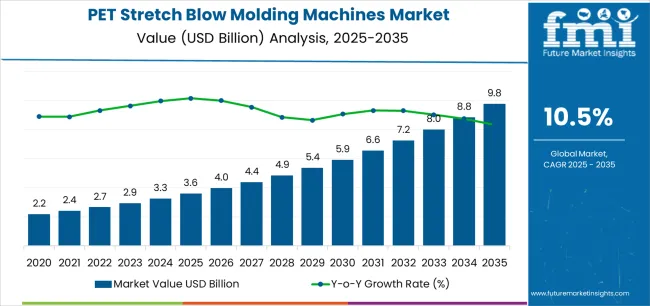
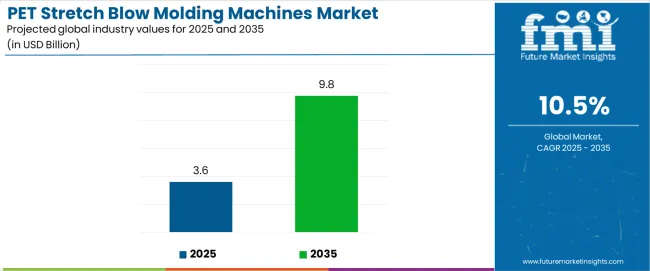
Between 2025 and 2030, the PET stretch blow molding machines market is projected to expand from USD 3.6 billion to USD 5.9 billion, resulting in a value increase of USD 2.3 billion, which represents 37.1% of the total forecast growth for the decade. This phase of development will be shaped by increasing demand for automated production systems, rising container quality requirements, and growing availability of advanced molding technologies across beverage manufacturing channels and packaging production establishments.
Between 2030 and 2035, the market is forecast to grow from USD 5.9 billion to USD 9.8 billion, adding another USD 3.9 billion, which constitutes 62.9% of the overall ten-year expansion. This period is expected to be characterized by the advancement of energy-efficient molding systems, the integration of intelligent automation technologies, and the development of high-performance machinery across diverse packaging categories. The growing emphasis on production efficiency and quality consistency will drive demand for certified equipment varieties with enhanced processing speed, improved material utilization, and superior operational reliability characteristics.
| Metric | Value |
|---|---|
| Estimated Value in (2025E) | USD 3.6 billion |
| Forecast Value in (2035F) | USD 9.8 billion |
| Forecast CAGR (2025 to 2035) | 10.5% |
From 2030 to 2035, the market is forecast to grow from USD 5.9 billion to USD 9.8 billion, adding another USD 3.9 billion, which constitutes 62.9% of the overall ten-year expansion. This period is expected to be characterized by the advancement of servo-driven technologies, the integration of precision control systems for premium machine production, and the development of specialized configurations for high-speed applications. The growing emphasis on production optimization and quality standards will drive demand for premium varieties with enhanced automation credentials, improved cycle time reduction, and superior performance characteristics.
Between 2020 and 2024, the PET stretch blow molding machines market experienced significant growth, driven by increasing awareness of production efficiency benefits and growing recognition of automated systems' effectiveness in supporting beverage operations across manufacturing segments and bottling applications. The market developed as users recognized the potential for stretch blow molding machines to deliver productivity advantages while meeting modern requirements for output consistency and reliable manufacturing practices. Technological advancement in material processing and quality control systems began emphasizing the critical importance of maintaining equipment performance while extending operational capabilities and improving customer confidence across diverse molding machine categories.
Market expansion is being supported by the increasing global demand for beverage packaging solutions and the corresponding shift toward automated production systems that can provide superior manufacturing outcomes while meeting user requirements for efficiency assurance and reliable production processes. Modern manufacturers are increasingly focused on incorporating advanced machinery that can enhance production capacity while satisfying demands for consistent, high-performing equipment and optimized bottling practices. Stretch blow molding machines' proven ability to deliver productivity benefits, quality consistency, and diverse application possibilities makes them essential equipment for packaging-intensive manufacturers and quality-conscious beverage companies.
The growing emphasis on production speed and operational efficiency is driving demand for high-performance molding machines that can support distinctive output outcomes and comprehensive quality positioning across beverage bottling, water packaging, and specialty container categories. User preference for equipment that combines processing excellence with reliability characteristics is creating opportunities for innovative implementations in both traditional and emerging packaging applications. The rising influence of automation standards and production optimization initiatives is also contributing to increased adoption of stretch blow molding machines that can provide authentic efficiency benefits and performance characteristics.
The market is segmented by machine type, technology, capacity, end-use industry, and region. By machine type, the market is divided into automatic machines, semi-automatic machines, and manual machines. Based on technology, the market is categorized into single-stage stretch blow molding and two-stage stretch blow molding. By capacity, the market includes up to 5,000 BPH, 5,000-10,000 BPH, and above 10,000 BPH. By end-use industry, the market encompasses beverage, food, pharmaceuticals, personal care & cosmetics, and other industries. Regionally, the market is divided into North America, Europe, Asia Pacific, Latin America, Middle East & Africa, and other regions.
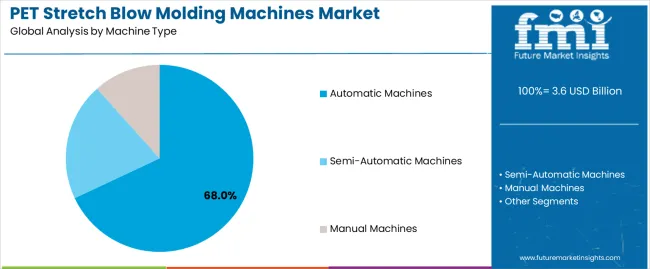
The automatic machines segment is projected to account for 68% of the PET stretch blow molding machines market in 2025, reaffirming its position as the leading equipment category. Manufacturers and beverage companies increasingly utilize automatic machines for their superior production characteristics, established efficiency performance, and essential functionality in high-volume manufacturing applications across diverse packaging categories. Automatic machines' standardized operational characteristics and proven productivity effectiveness directly address user requirements for reliable production capacity and optimal manufacturing value in commercial applications.
This equipment segment forms the foundation of modern beverage packaging patterns, as it represents the format with the greatest industrial acceptance potential and established compatibility across multiple production systems. Manufacturing investments in automation optimization and efficiency standardization continue to strengthen adoption among quality-conscious companies. With users prioritizing production speed and operational reliability, automatic machines align with both efficiency objectives and performance requirements, making them the central component of comprehensive packaging manufacturing strategies.
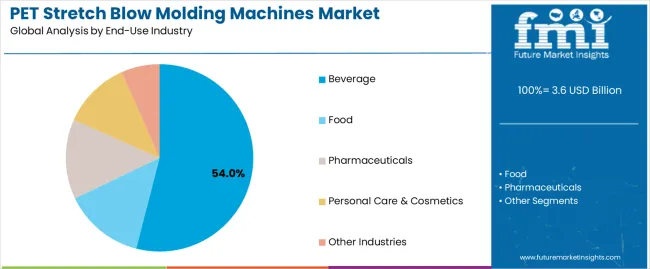
The beverage industry is projected to represent 54% of the PET stretch blow molding machines market growth through 2035, underscoring its critical role as the primary choice for volume-focused manufacturers seeking superior production benefits and enhanced output credentials. Beverage producers and bottling facility operators prefer stretch blow molding machines for their enhanced speed standards, proven efficiency superiority, and ability to maintain exceptional quality profiles while supporting high-capacity operations during large-scale manufacturing experiences. Positioned as essential equipment for demanding producers, beverage-focused offerings provide both productivity excellence and reliability advantages.
The segment is supported by continuous improvement in bottle design technology and the widespread availability of established manufacturing infrastructure that enables quality assurance and premium positioning at the industrial level. Additionally, machine manufacturers are optimizing molding process methods to support market differentiation and accessible automation pricing. As production technology continues to advance and users seek superior efficiency solutions, beverage applications will continue to drive market growth while supporting container quality and manufacturing optimization strategies.
The PET stretch blow molding machines market is advancing rapidly due to increasing beverage consumption consciousness and growing need for automated manufacturing choices that emphasize superior production outcomes across packaging segments and bottling applications. However, the market faces challenges, including higher capital investment costs, maintenance requirements for automated systems, and technical complexity affecting operator training needs. Innovation in servo technologies and specialized machine development continues to influence market development and expansion patterns.
The growing adoption of stretch blow molding machines in large-scale beverage programs and capacity-intensive applications is enabling manufacturers to develop production patterns that provide distinctive efficiency benefits while commanding premium positioning and enhanced output characteristics. High-speed applications provide superior productivity density while allowing more sophisticated bottle manufacturing across various packaging categories. Users are increasingly recognizing the competitive advantages of automated machine positioning for premium production efficiency and quality-conscious operational integration.
Modern stretch blow molding machine manufacturers are incorporating advanced control systems, automation technologies, and quality monitoring protocols to enhance production capabilities, improve manufacturing outcomes, and meet industrial demands for process-specific optimization solutions. These systems improve machine effectiveness while enabling new applications, including integrated diagnostics and specialized configuration programs. Advanced automation integration also allows manufacturers to support premium market positioning and efficiency leadership beyond traditional molding operations.
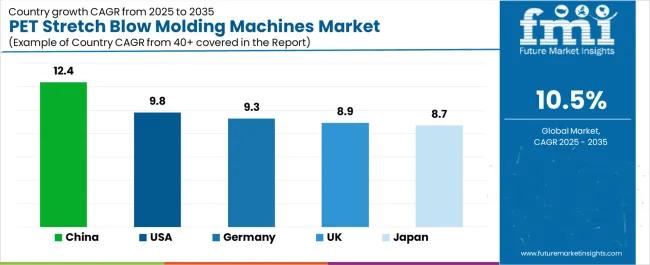
| Country | CAGR (2025-2035) |
|---|---|
| USA | 9.8% |
| Germany | 9.3% |
| UK | 8.9% |
| China | 12.4% |
| Japan | 8.7% |
The PET stretch blow molding machines market is experiencing robust growth globally, with China leading at a 12.4% CAGR through 2035, driven by the expanding beverage manufacturing sector, growing packaging sophistication, and increasing adoption of automated production equipment. The USA follows at 9.8%, supported by rising bottling capacity expansion, advancing manufacturing infrastructure, and growing acceptance of high-speed molding solutions. Germany shows growth at 9.3%, emphasizing established packaging markets and comprehensive production technology development. The UK records 8.9%, focusing on premium manufacturing equipment and beverage industry expansion. Japan demonstrates 8.7% growth, prioritizing precision molding solutions and technological advancement.
The report covers an in-depth analysis of 40+ countries top-performing countries are highlighted below.
Revenue from PET stretch blow molding machines consumption and sales in the USA is projected to exhibit exceptional growth with a CAGR of 9.8% through 2035, driven by the country's rapidly expanding beverage production sector, favorable manufacturing attitudes toward automation solutions, and initiatives promoting production efficiency optimization across major bottling regions. The USA's position as a leading beverage market and increasing focus on manufacturing technology development are creating substantial demand for high-performance molding machines in both commercial and industrial markets. Major equipment suppliers and specialty machinery providers are establishing comprehensive distribution capabilities to serve growing manufacturing demand and emerging automation opportunities.
Revenue from PET stretch blow molding machines products in Germany is expanding at a CAGR of 9.3%, supported by rising packaging sophistication, growing industrial precision, and expanding production automation infrastructure. The country's developing manufacturing capabilities and increasing industrial investment in quality equipment are driving demand for molding machines across both imported and domestically produced applications. International machinery companies and domestic manufacturers are establishing comprehensive distribution networks to address growing market demand for quality molding systems and production solutions.
Revenue from PET stretch blow molding machines products in the UK is projected to grow at a CAGR of 8.9% through 2035, supported by the country's mature beverage manufacturing market, established quality culture, and leadership in production standards. Britain's sophisticated industrial infrastructure and strong support for automation advancement are creating steady demand for both traditional and innovative molding machine varieties. Leading equipment suppliers and specialty machinery providers are establishing comprehensive operational strategies to serve both domestic markets and growing export opportunities.
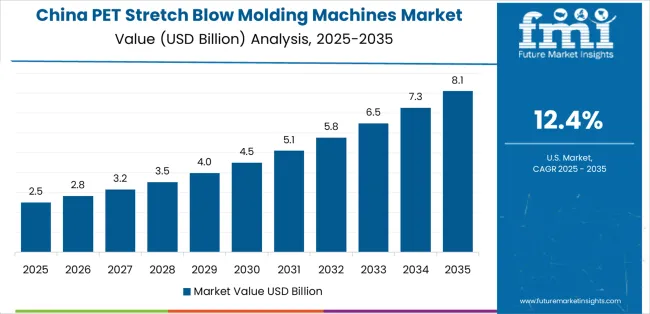
Revenue from PET stretch blow molding machines products in China is projected to grow at a CAGR of 12.4% through 2035, driven by the country's emphasis on beverage expansion, manufacturing leadership, and sophisticated production capabilities for packaging requiring specialized automated varieties. Chinese manufacturers and bottlers consistently seek industrial-grade equipment that enhances production efficiency and supports manufacturing operations for both traditional and innovative beverage applications. The country's position as an Asian manufacturing leader continues to drive innovation in specialty molding machine applications and industrial equipment standards.
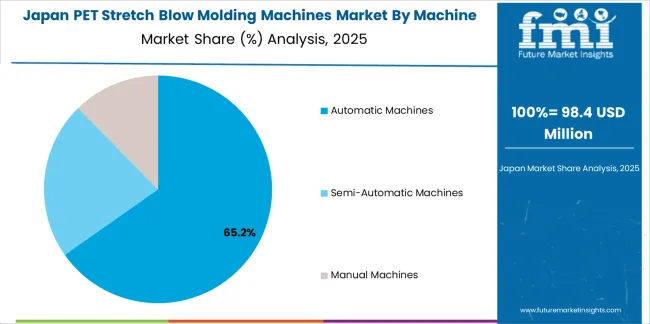
Revenue from PET stretch blow molding machines products in Japan is projected to grow at a CAGR of 8.7% through 2035, supported by the country's emphasis on quality manufacturing, production efficiency standards, and advanced technology integration requiring efficient molding solutions. Japanese manufacturers and beverage producers prioritize quality performance and precision equipment, making stretch blow molding machines essential components for both traditional and modern packaging applications. The country's comprehensive manufacturing excellence and advancing industrial patterns support continued market expansion.
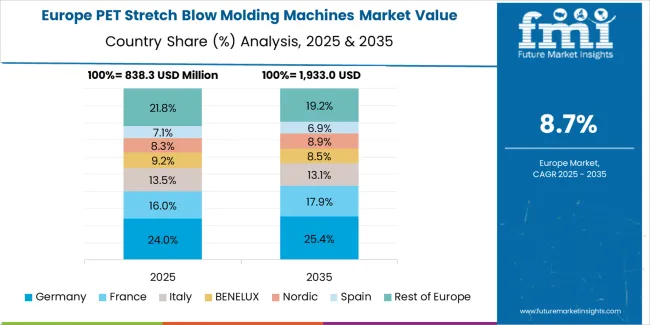
The Europe PET stretch blow molding machines market is projected to grow from USD 1.1 billion in 2025 to USD 2.6 billion by 2035, recording a CAGR of 9.0% over the forecast period. Germany leads the region with a 35.0% share in 2025, moderating slightly to 34.5% by 2035, supported by its strong beverage manufacturing culture and demand for premium, professionally engineered molding equipment. The United Kingdom follows with 21.0% in 2025, easing to 20.5% by 2035, driven by a sophisticated packaging market and emphasis on quality and efficiency standards. France accounts for 19.5% in 2025, rising to 20.0% by 2035, reflecting steady adoption of automated production solutions and manufacturing consciousness. Italy holds 12.5% in 2025, expanding to 13.0% by 2035 as industrial modernization and specialty beverage applications grow. Spain contributes 6.5% in 2025, growing to 7.0% by 2035, supported by expanding bottling operations and manufacturing equipment adoption. The Nordic countries rise from 4.0% in 2025 to 4.5% by 2035 on the back of strong quality adoption and advanced production integration. BENELUX remains at 1.5% share across both 2025 and 2035, reflecting mature, technology-focused markets.
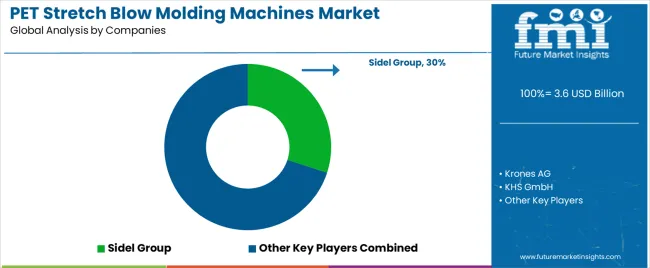
The PET stretch blow molding machines market is characterized by competition among established machinery manufacturers, specialized equipment producers, and integrated automation solution providers. Companies are investing in servo technologies, advanced control systems, product innovation capabilities, and comprehensive service networks to deliver consistent, high-quality, and reliable molding machines. Innovation in efficiency enhancement, energy-saving production methods, and application-specific equipment development is central to strengthening market position and customer satisfaction.
Sidel Group leads the market with a strong focus on automation innovation and comprehensive beverage production solutions, offering premium molding machines with emphasis on efficiency excellence and manufacturing heritage. Krones AG provides specialized machinery manufacturing capabilities with a focus on European market applications and integrated production networks. KHS GmbH delivers integrated bottling solutions with a focus on quality positioning and operational efficiency. Nissei ASB Machine Co., Ltd. specializes in comprehensive molding systems with an emphasis on single-stage technology applications. Jomar Corporation focuses on comprehensive industrial solutions with advanced engineering and premium positioning capabilities.
The success of stretch blow molding machines in meeting industrial production demands, efficiency-driven manufacturing requirements, and quality assurance integration will not only enhance packaging outcomes but also strengthen global beverage capabilities. It will consolidate emerging regions' positions as hubs for efficient machine manufacturing and align advanced economies with automated production systems. This calls for a concerted effort by all stakeholders - governments, industry bodies, suppliers, distributors, and investors. Each can be a crucial enabler in preparing the market for its next phase of growth.
| Items | Values |
|---|---|
| Quantitative Units (2025) | USD 3.6 billion |
| Machine Type | Automatic Machines, Semi-Automatic Machines, Manual Machines |
| Technology | Single-Stage Stretch Blow Molding, Two-Stage Stretch Blow Molding |
| Capacity | Up to 5,000 BPH, 5,000-10,000 BPH, Above 10,000 BPH |
| End-Use Industry | Beverage, Food, Pharmaceuticals, Personal Care & Cosmetics, Other Industries |
| Regions Covered | North America, Europe, Asia Pacific, Latin America, Middle East & Africa, Other Regions |
| Countries Covered | United States, Germany, United Kingdom, China, Japan, and 40+ countries |
| Key Companies Profiled | Sidel Group, Krones AG, KHS GmbH, Nissei ASB Machine Co., Ltd., Jomar Corporation, and other leading molding machine companies |
| Additional Attributes | Dollar sales by machine type, technology, capacity, end-use industry, and region; regional demand trends, competitive landscape, technological advancements in servo systems engineering, automation integration initiatives, efficiency enhancement programs, and premium equipment development strategies |
The global pet stretch blow molding machines market is estimated to be valued at USD 3.6 billion in 2025.
The market size for the pet stretch blow molding machines market is projected to reach USD 9.8 billion by 2035.
The pet stretch blow molding machines market is expected to grow at a 10.5% CAGR between 2025 and 2035.
The key product types in pet stretch blow molding machines market are automatic machines, semi-automatic machines and manual machines.
In terms of end-use industry, beverage segment to command 54.0% share in the pet stretch blow molding machines market in 2025.






Full Research Suite comprises of:
Market outlook & trends analysis
Interviews & case studies
Strategic recommendations
Vendor profiles & capabilities analysis
5-year forecasts
8 regions and 60+ country-level data splits
Market segment data splits
12 months of continuous data updates
DELIVERED AS:
PDF EXCEL ONLINE
Key Companies & Market Share in PET Stretch Blow Molding Machines Sector
Pet Shampoo Market Size and Share Forecast Outlook 2025 to 2035
Pet Perfume Market Size and Share Forecast Outlook 2025 to 2035
Pet Tick and Flea Prevention Market Forecast and Outlook 2025 to 2035
Pet Hotel Market Forecast and Outlook 2025 to 2035
PET Vascular Prosthesis Market Size and Share Forecast Outlook 2025 to 2035
Pet Food Preservative Market Forecast and Outlook 2025 to 2035
Petroleum Liquid Feedstock Market Size and Share Forecast Outlook 2025 to 2035
Pet Food Ingredients Market Size and Share Forecast Outlook 2025 to 2035
PET Injectors Market Size and Share Forecast Outlook 2025 to 2035
PET Material Packaging Market Size and Share Forecast Outlook 2025 to 2035
Petri Dishes Market Size and Share Forecast Outlook 2025 to 2035
Petroleum And Fuel Dyes and Markers Market Size and Share Forecast Outlook 2025 to 2035
Petrochemical Pumps Market Size and Share Forecast Outlook 2025 to 2035
PET Dome Lids Market Size and Share Forecast Outlook 2025 to 2035
Pet Dietary Supplement Market Size and Share Forecast Outlook 2025 to 2035
PET Imaging Workflow Market Analysis - Size, Share, and Forecast Outlook 2025 to 2035
Petroleum Refinery Merchant Hydrogen Generation Market Size and Share Forecast Outlook 2025 to 2035
Pet Bird Health Market Size and Share Forecast Outlook 2025 to 2035
PET Film Coated Steel Coil Market Size and Share Forecast Outlook 2025 to 2035

Thank you!
You will receive an email from our Business Development Manager. Please be sure to check your SPAM/JUNK folder too.
Chat With
MaRIA